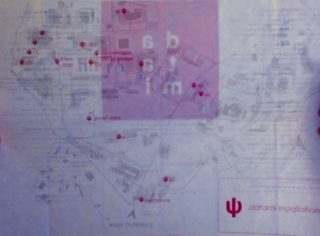The name of the III Edition of the Resonances Festival 2019 at the Joint Research Center (JRC), Ispra Italy, was Datami. The theme of the Festival was in fact Big Data. “The word – as they explain at the JRC – refers to the concept of the multifunctional Japanese tatami mats – places of action, of meditation and of rest”. It becomes then a metaphor of the digital intertwining of our lives in-between real life and digital life. And now imagine a team of scientists and artists working together to let this concept take shape through masterpieces of SciArt to be offered to the JRC visitors. We had the pleasure to be visitors last month in the week going from 14 to 18 Oct. A week to celebrate not only the resulting works of a SciArt collaboration but also the work of all JRC staff.
Every two years, since 2015, JRC is the theatre of the Resonance Festival. And the Festival is the results of two-year work co-ordinated by the SciArt Project Leader Adriaan Eeckels, the Curator Feddie Paul Grunert, Jutta-thelen del Pozo Head of the Scientific Development Unit at the JRC and Scientist Francesco Mugnai. A magical touch is added by the Architect Cristina Fiordimela, responsible of the Exhibition Set-up. During the two years, scientists and artists meet during an intense Summer School, the first step for artists to acquire the scientific basis for their future installation. In the next months, they will work together to get inspired one another and to give birth to the work of Art. The results, believe it, is amazing.

Also for Datami the exhibits were disseminated in the whole area of the centre, reinterpreting the space with colours, sounds, and “cinematographic” scenes, in contrast with the rational asset of research centres. Every installation was interpreting in an original way the use of Big Data in Science, enriching the space around visitors. We were mostly captured by those installations requing an active part from the visitors. One, The Tannhauser gate developed by artist Giorgio Sancristoforo in collaboration with Valentina Parocchini, Mauro Petrillo, Vittorio Forcina, Paolo Peerani e Cristina Fiordimela; The installation required the visitors passing through two pillars (similar to the Monolith in Stanley Kubrik A 2001 Space Odissey) containing the artist’s DNA. In doing so, the visitor mutates the DNA. In fatc, at the base of each “black monolith” a radioactive material is released while the visitors pass through the two pillars. The mutation is signalized by coloured lights in the installation and by some weird sounds. G. Sancristoforo who defines himself a nuclear artist was denying any environmental message coming out from the installation. He loves nuclear in itself and nuclear material is often part of his installations.
Another installation involving visitors as an active part was in the JRC area dedicated to the Car Crash Test. Nature of Knowledge the Uncertain Structure by artist Jenny Brockmann in collaboration with Pierre Pegon, Diana Rembges and Marcelo Masera invited visitors to enter inside a huge labyrinth. In stepping in, the visitors are factors causing the disruption of a crash test in the near bulding (the ELSA Lab) dedicated to seismic engineering. Entering the labyrinth gives every visitor different emotions, so everybody is invited to report their feelings at the end of the visit in a sort of scrapbook.
Not less charming were those installations with a “cinematographic set”. Imagine weather forecasts in an Era when electronic computers didn’t exist. Who would dare today to start a similar enterprise? The couple of artists Lise Autogena & Joshua Portway, in collaboration with Jutta Thielen Del-Pozo and Florian Pappenberger paid a tribute to Lewis Fry Richardson who between 1916 and 1919 produced the first modern weather forecast. Since electronic computers didn’t exist, he had to do every single calculation by hand. Similarly, entering the installation Weather Prediction By Numerical Process we have found the two artists working in the same way, making calculation by hand. In fact, in collaboration with mathematicians and climate experts Portway and Autogena have adapted Fry-Richardson’s original algorithm. Besides, using data from the European Centre for Medium-Range Weather Forecasts they set themselves to attempt performing a forecast for Europe on the 31st October.
Finally, impossible not to be impressed by the beauty of Gaia 5.0: A Holographic Image Ambience, of artist Renate Quehenberger in collaboration with Rita Van Dingenen, Thomas Petroliagkis, Andreas Wierse, Luoise Arnal and Kristian Mogensen (ECMWF), Uwe Wossner and Leyla Kern (HLRS Stuttgart). The Earth is here represented as a multi-dimensional dynamic holographic model. By combining the Copernicus data of aerosol dynamics in the atmosphere with ocean data sets of the very severe cyclonic storms (Luban and Titli) over the Arabian sea and the Bay of Bengal in October 2018, a visual scenario is offered to the visitors. Together with the sound of a very grim voice in the back ground the visitor is involved in an alarming mood suggesting that the Earth is in a state of emergency: there is no time to wait. Act now! No better voice could have been chosen! The voice belongs to Lydia Lunch, an American singer, poet, writer, actress and self-empowerment speaker.
We had the pleasure to host Renate at EGU2019 General Assembly and also Nicolas Strappini who will also be with us at AGU2019 next month. Melanie King took part in EGU2018. R. Quehenberger will also publish together with her co-authors a paper about GAIA 5.0 in our Special Issue dedicated to Five Years of Earth Sciences and Art at EGU.
The next appointment for the artists and their installations is at the Centre for Fine Arts BOZAR, in Brussels in Dec.
We have quoted here just few installations, for obvious reasons. But every installation was worth to be experienced. Here you can find more info:
https://resonances.jrc.ec.europa.eu/datami
https://www.facebook.com/resonancesIII/
Have also a look at the video we prepared for you: